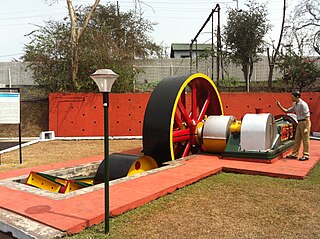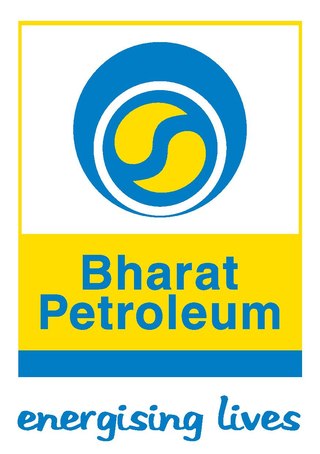This article needs editing to comply with Wikipedia's Manual of Style.(May 2024) |
The history of the Indian oil industry extends back to the period of the British Raj, at a time when petroleum first became a primary global energy source.
This article needs editing to comply with Wikipedia's Manual of Style.(May 2024) |
The history of the Indian oil industry extends back to the period of the British Raj, at a time when petroleum first became a primary global energy source.
1866 : Oil discovery at Nahorpung, Assam. Not explored. 1882 : Big "Oil Seepage" in Digboi during construction of Dibrugarh-Ledo Railway Line. The first oil production started in India in 1889 near the town of Digboi in the state of Assam. A Small thatched structure was erected and christened "Oil well no.1" or "Discovery". [1] This discovery came on the heels of industrial development. The Assam Railways and Trading Company (ARTC) had recently opened the area for trade by building a railway and later finding oil nearby. The first well was completed in 1890 and in 1893 first refinery started at Margharita, Assam. [2] The Assam Oil Company was established in 1899 to oversee production. In 1901, Digboi Refinery was commissioned supplanting the earlier refinery at Margharita. At its peak during the Second World War the Digboi oil fields were producing 7,000 barrels per day.[ citation needed ]. In the year 1909, IBP (Indo Burmah Petroleum) was incorporated in Rangoon to explore oil wells that had been discovered in Burma and Assam. [3]
Oil in colonial India was mostly exploited by a number of British companies with intricate alliances. Their output began to increase during the first and second world wars to support British troops and industries in the United Kingdom. [4]
In 1928, Asiatic Petroleum Company ( India) started cooperation with Burmah Oil Company. This alliance led to the formation of Burmah-Shell Oil Storage and Distributing Company of India Limited. Burmah-Shell began its operations with import and marketing of Kerosene. On 24 January 1976, the Burmah Sell was taken over by the Government of India to form Bharat Refineries Limited. On 1 August 1977, it was renamed as Bharat Petroleum Corporation Limited. [5]
After India won independence in 1947, the new government moved to a less exploitative system, often termed as License Raj. In terms of economic policy this meant a far bigger role for the government and little or no role for the private sector. This resulted in a bureaucratic system that meant a large public sector and focus on centralized planning. [6]
The foreign companies continued to play a key role in the oil industry. Oil India Limited was still a joint venture involving the Indian government and the British owned Burmah Oil Company (presently, BP) whilst the Indo-Stanvac Petroleum project in West Bengal was between the Indian government and the American company SOCONY-Vacuum (presently, ExxonMobil). [7] This changed in 1956 when the government adopted an industrial policy that placed oil as a “schedule A industry” and put its future development in the hands of the state. [7] In October 1959 an Act of Parliament was passed which gave the state owned Oil and Natural Gas Commission (ONGC) the powers to plan, organise, and implement programmes for the development of oil resources and the sale of petroleum products and also to perform plans sent down from central government.
In order to find the expertise necessary to reach these goals foreign experts from West Germany, Romania, the US, and the Soviet Union were brought in. [7] The Soviet experts were the most influential and they drew up detailed plans for further oil exploration which were to form part of the second five-year plan. India thus adopted the Soviet model of economic development and the state continues to implement five-year plans as part of its drive towards modernity. [8] The increased focus on exploration resulted in the discovery of several new oil fields most notably the off-shore Bombay High field which remains by a long margin India's most productive well. [7]
The process of economic liberalisation in India began in 1991 when India defaulted on her loans and asked for a $1.8 billion bailout from the IMF. [9] This was a trickle-down effect of the culmination of the cold war era; marked by the 1991 collapse of the Soviet Union, India's main trading partner. The bailout was done on the condition that the government initiate further reforms, thus paving the way for India's emergence as a free market economy, which would open up its markets to western companies. [10]
For the ONGC this meant being reorganised into a public limited company (it is now called for Oil and Natural Gas Corporation) and around 2% of government held stocks were sold off. [7] Despite this however the government still plays a pivotal role and ONGC is still responsible for 77% of oil and 81% of gas production while the Indian Oil Corporation (IOC) owns most of the refineries putting it within the top 20 oil companies in the world. [11] The government also maintains subsidised prices. [11] As a net importer of oil however India faces the problem of meeting the energy demands for its rapidly expanding population and economy and to this the ONGC has pursued drilling rights in Iran and Kazakhstan and has acquired shares in exploration ventures in Indonesia, Libya, Nigeria, and Sudan. [11]
India's choice of energy partners however, most notably Iran led to concerns radiating from the US. [11] A key issue today is the proposed gas pipeline that will run from Turkmenistan to India through politically unstable Afghanistan and also through Pakistan. [11] However, despite India's strong economic links with Iran, India voted with the US when Iran's nuclear program was discussed by the International Atomic Energy Agency although there are still very real differences between the two countries when it comes to dealing with Iran. [11]

BP Canada was a Canadian petroleum company and subsidiary of British Petroleum that existed between 1955 and 1992. The name refers to a group of companies that engaged in various segments of the petroleum industry lifecycle. BP entered the Canadian market in October 1953, when it purchased a 23 percent stake in the Triad Oil Company. In 1955, BP formed a Canadian subsidiary, based in Montreal, called BP Canada Limited. The company began acquiring retail stations in Ontario and Quebec and in 1957 started construction on a refinery in Montreal. By the end of the 1950s BP Canada was a fully-integrated operation. In 1964, it acquired from Cities Service the Oakville Refinery, and then expanded its operations significantly in 1971 when it acquired Supertest Petroleum.
Oil India Limited (OIL) is a central public sector undertaking engaged in the business of exploration, development and production of crude oil and natural gas, transportation of crude oil and production of liquid petroleum gas. The central public sector undertaking is a Maharatna, with the Ministry of Petroleum and Natural Gas overseeing its operations. Headquartered in Duliajan, Assam, the company has its offices in Duliajan, Noida, Guwahati and Jodhpur.
Waman "Dādā" Bapuji Metre was the doyen of Indian petroleum geologists. He was awarded India's third-highest civilian award, the Padma Bhushan in 1968, for his contribution to petroleum exploration and development in India and for his 'significant contribution to the growth of the oil industry in the country'.

Digboi Oil Refinery was set up at Digboi in 1901 by Assam Oil Company Ltd. The Indian Oil Corporation Ltd (IOC) took over the refinery and marketing management of Assam Oil Company Ltd. with effect from 1981 and created a separate division. This division has both refinery and marketing operations. The refinery at Digboi had an installed capacity 0.5 million tonnes per year. The refining capacity of the refinery was increased to 0.65 million tonnes per year by modernization of refinery in July, 1996. A new delayed Coking Unit of 170,000 tonnes per year capacity was commissioned in 1999. A new Solvent Dewaxing Unit for maximizing production of microcrystalline wax was installed and commissioned in 2003. The refinery has also installed Hydrotreater-UOP in 2002 to improve the quality of diesel. The MSQ Upgradation unit has been commissioned. A new terminal was expected to be completed by 2016. It is one of the best oil fields in Assam. Certified

The Oil and Natural Gas Corporation Limited (ONGC) is an Indian central public sector undertaking under the ownership of Ministry of Petroleum and Natural Gas, Government of India. The company is headquartered in Delhi. ONGC was founded on 14 August 1956 by the Government of India. It is the largest government-owned-oil and gas explorer and producer in the country and produces around 70 percent of India's domestic production of crude oil and around 84 percent of natural gas. ONGC is vertically integrated across the entire oil and gas industry. In November 2010, the Government of India conferred the Maharatna status to ONGC.

Bharat Petroleum Corporation Limited (BPCL) is an Indian public sector undertaking (PSU) under the ownership of the Ministry of Petroleum and Natural Gas, Government of India. It operates three refineries in Bina, Kochi and Mumbai. BPCL is India's second-largest government-owned downstream oil producer, whose operations are overseen by the Ministry of Petroleum and Natural Gas. BPCL was ranked 309th on the Fortune list of the world's biggest PSUs in 2020, and 792nd on Forbes's "Global 2000" list in 2021.

Hindustan Petroleum Corporation Limited (HPCL) is an Indian public sector undertaking in petroleum and natural gas industry, headquartered in Mumbai, and a subsidiary of the Oil and Natural Gas Corporation (ONGC), which is owned by the Ministry of Petroleum and Natural Gas, Government of India.

The Ministry of Petroleum and Natural Gas (MOP&NG) is a ministry of the government of India responsible for the exploration, production, refining, distribution, marketing, import, export, and conservation of petroleum, natural gas, petroleum products, and liquefied natural gas in the country. The ministry is headed by the Cabinet Minister Hardeep Singh Puri. M. M. Kutty is the Secretary of the Ministry. Dharmedndra Pradhan serving as the minister from 26 May 2014 to 7 July 2021 is the longest serving minister till date.

GAIL (India) Limited is an Indian state-owned energy corporation with primary interests in the trade, transmission and production distribution of natural gas. GAIL also has interests in the exploration and production solar and wind power, telecom and telemetry services (GAILTEL) and electricity generation. GAIL was founded as the Gas Authority of India Ltd. in August 1984 under the Ministry of Petroleum and Natural Gas to build, operate and maintain the HVJ Gas Pipeline. On 1 February 2013, the Indian government conferred GAIL with Maharatna status along with 11 other Public Sector Undertakings (PSUs).

The Economy of Assam is largely agriculture based with 69% of the population engaged in it.

Krishna Godavari Basin is a peri-cratonic passive margin basin in India. It is spread across more than 50,000 square kilometres in the Krishna River and Godavari River basins in Andhra Pradesh. The site is known for the D-6 block where Reliance Industries discovered the biggest natural gas reserves in India in 2003.
New Exploration Licensing Policy (NELP) was conceptualised by the Government of India, during 1997-98 to provide an equal platform to both Public and Private sector companies in exploration and production of hydrocarbons with Directorate General of Hydrocarbons (DGH) as a nodal agency for its implementation. It was introduced to boost the production of oil and natural gas and providing level playing field for both public and private players.
The Kaveri delta coal-bed methane extraction project is a series of projects to extract methane gas and hydrocarbon from coal-bed by using hydraulic fracturing in the Kaveri river basin in Tamil Nadu, India. The extraction projects faced series of opposition from the farmers, environmentalists, and experts as exploration areas covering Nagapattinam, Thanjavur and Thiruvarur districts which are the major rice cultivating area of Tamil Nadu.
The Petroleum Division, is a part of Ministry of Energy (Pakistan) responsible for ensuring the availability and security of sustainable supply of oil and gas for economic development and strategic requirements of Pakistan and to coordinate development of natural resources of energy and minerals.
Public Sector Undertakings (PSU) or Public Sector Enterprises (PSE) in India are government-owned enterprises in which 51 percent or more share capital is held by the Government of India or state governments or joint ventures between multiple Public Sector Enterprises. Depending on the level of government ownership, they can be broadly categorised as Central PSUs or State PSUs. These entities include government companies, statutory corporations, banking institutions, and departmentally run companies. PSUs are officially classified into three categories, which are Central Public Sector Enterprises (CPSE) and Public Sector Banks (PSB) owned by the central government or other CPSEs/PSBs, and State Level Public Enterprises (SLPE) owned by state governments or other SLPEs. CPSE is further classified into Strategic Sector and Non-Strategic Sector. Depending on their financial performance and progress, CPSEs are granted the status of Maharatna, Navaratna, and Miniratna.
Bangladesh is the sixteenth-largest producer of natural gas in Asia. Gas supplies meet 56% of domestic energy demand. However, the country faces an acute energy crisis in meeting the demands of its vast and growing population. Bangladesh is a net importer of crude oil and petroleum products. The energy sector is dominated by state-owned companies, including Petrobangla and the Bangladesh Petroleum Corporation. Chevron, ConocoPhillips, Equinor, Gazprom and ONGC are major international companies engaged in Bangladesh's hydrocarbon industry, with Chevron's gas fields accounting for 50% of natural gas production.

Indian Oil Corporation Limited is an Indian oil and gas company under the ownership of the Ministry of Petroleum and Natural Gas, Government of India. Headquartered in New Delhi, it is a public sector undertaking whose operations are overseen by the Ministry of Petroleum and Natural Gas. Indian Oil is ranked 94th on the Fortune Global 500 list of the world's biggest corporations as of 2022. It is the largest government owned oil producer in the country both in terms of capacity and revenue. It has consolidated refining capacity of 80.55MMTPA which it intends to increase to 107MMTPA by 2024-25. As of 31 March 2021, Indian Oil's employee strength is 31,648, out of which 17,762 are executives and 13,876 non-executives, while 2,776 are women, comprising 8.77% of the total workforce.
The petroleum industry in India dates back to 1889 when the first oil deposits in the country were discovered near the town of Digboi in the state of Assam. The natural gas industry in India began in the 1960s with the discovery of gas fields in Assam and Maharashtra. As on 31 March 2018, India had estimated crude oil reserves of 594.49 million metric tonnes (Mt) and natural gas reserves of 1339.57 billion cubic metres of natural gas (BCM).

Ashoknagar oilfield is a petroleum extracting site located at Ashoknagar in the North 24 Parganas district, West Bengal. The oil field is located 48 km from the state capital Kolkata. The oil field was discovered in 2018 by Oil and Natural Gas Corporation. This is the first oil field in West Bengal and East India.
{{cite web}}: Check |url= value (help)